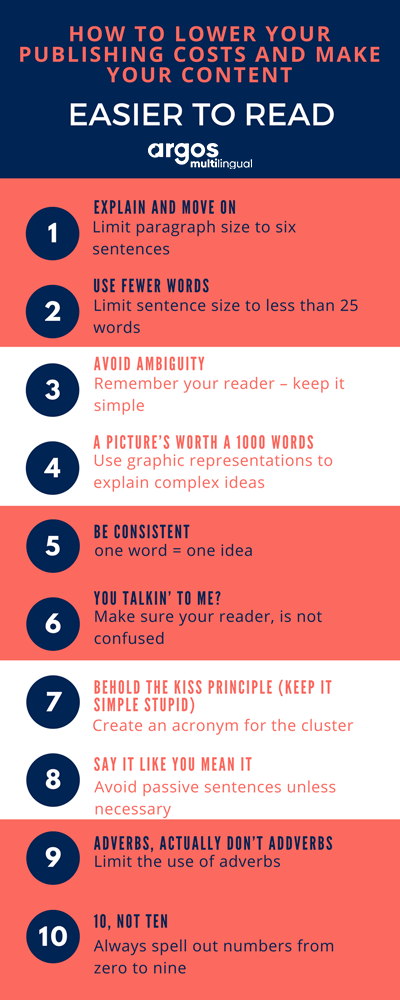
Argos Multilingual Acquires ENLASO Corporation
Blog
・6 min read
This Top 10 List follows the principles of STE* and shows you how to lower your publishing costs and make your content easier to read. Simplified Technical English (STE) starts with the words you choose and the writing style that you use for your source content. When you use STE methods, you will write more clearly and concisely. This will result in better documentation for the users of your products and can also directly reduce your translation and localization costs.
 1. Explain and move on
1. Explain and move onWriters often explain their ideas in complex ways creating a breeding ground for ambiguity and mistakes. Limit paragraph size to six sentences or less – five to six sentences are optimum. Let your last sentence relate to the next paragraph and use only one idea per sentence.
Large English vocabulary can increase the ambiguity risk. Limit sentence size to less than 25 words – 15 is optimum. For technical texts, don’t be afraid to say it: “Turn the switch to ON”. Rather than: “To turn the machine on, push the switch down to move it into the ON position”.
Hence, STE is great for cutting down your content – often by as much as 25%. This reduces the words that need to be published and translated.
Choose words carefully to avoid ambiguity. This is especially important, when you’re writing instructions with commands, and are using words like “close” that can have multiple meanings. Instead of “close” write “near”. Don’t write “initiate” instead write “start”. Remember your reader – keep it simple.
Use graphic representations to explain complex ideas. Writing to a graphic helps you structure your thoughts, sentences and word choices.
Be consistent in the terms used, one word = one idea. Do not call it a “device” on one page, a “unit” on another or a “machine” on the third. This will only confuse the reader.
Your mom doesn’t like it when you call her “mother” at a reception or “ma” when complaining.
Audience assessment – are you writing to an audience of PhDs or perhaps to a reader who didn’t complete secondary school? Remember, writing isn’t an academic exercise – you are trying to communicate and be understood. Make sure your reader, is not confused with your content.
Complexity is often caused by noun clusters – avoid them! Create an acronym or substitute a single word for the cluster. Do not say “the portable rigid spoke analyzer’” say the “analyzer”, or for Portable Oxygen SpO2 Monitor, define it as POSM and use the acronym instead.
Rather than writing in a passive voice STE forces you to write in an active voice. Avoid passive sentences unless necessary. This mostly applies to instruction-type-content, where you should always use active tense.
The temperature must not be set to over 100 C (centigrade). INCORRECT
Do not set the temperature above 100 C (centigrade). CORRECT
Once STE principles are applied, the same text can be trimmed down, by over 30%, while keeping all the relevant information intact.
Limit the use of adverbs – check and see if the sentence can stand alone without an adverb. Always avoid: simply, badly or hardly.
Always spell out numbers from zero to nine. For numbers 10 and above use the numeral. Do not start a sentence with numerals (say “Thirty-five documents…” not “35 documents…”). Also, use numerals, not words to express percentages (use 55%, not fifty-five percent).
At Argos, we have taken the core principles of STE (including rules, vocabulary and dictionary building) and made them applicable to all content. This means we help companies in multiple industries (from banking to medical), implement STE-like processes and apply it to all types of documentation, such as technical and even in some cases marketing content. Have a look at our video on that topic or get to know our value-added consulting services.
*Simplified Technical English – often abbreviated to STE – is a system of controlled writing based on the principles of the ASD-STE100 standard. The standard was developed by the aerospace and defense industries association in the 1970’s in order to simplify aircraft maintenance documentation and eliminate safety risks introduced by non-native mechanics working on aircraft worldwide.
What to read next...
Want to know more?
The latest industry news, interviews, technologies, and resources.
View all resourcesGet in touch
We are committed to giving you freedom of choice while providing subject matter expertise and customized strategies to fit your business needs.
Contact us